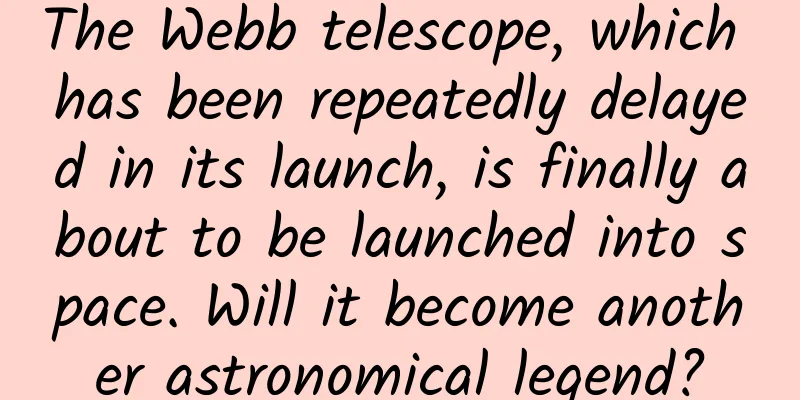The Webb telescope, which has been repeatedly delayed in its launch, is finally about to be launched into space. Will it become another astronomical legend?

|
The full name of the Webb Telescope is James Webb Space Telescope, abbreviated as JWST. James Webb is actually the name of a deceased person. He was the second director of NASA (National Aeronautics and Space Administration). During his tenure, he made outstanding contributions to the space industry of the United States and even mankind. The lunar exploration project and the Apollo manned moon landing were both his masterpieces. In order to commemorate and recognize his outstanding contributions to the space industry, NASA named this most advanced space observatory to date after him, which is well deserved. The Webb telescope has left many "legends" before it was launched into space These "legends" were too difficult to create and the additional investment was too outrageous. According to the earliest plan, the Webb telescope (sometimes referred to as Webb) was to be launched in 2014. Later, it was changed to October 2018. Later, it was postponed to March-June 2019. Later, it was postponed to 2020. It was still not possible and was postponed to March 2021. Now all this has become the past, and the Webb telescope is still squatting on the earth. On October 12, 2021, the Webb telescope was finally transported to the French Guiana rocket launch site in South America, ready to be launched there. The reason why it was not launched at NASA's own base in the United States is that this launch site is near the equator, and the rotation of the earth gives the greatest boost to the rocket's speed, so the same amount of fuel can launch a larger payload. But the delayed launch effect seems to have not ended yet: the launch was initially scheduled for October 18, but was later postponed to December 22, and then to December 24. The latest news is that due to bad weather, the launch has been postponed to December 25. In the past, it was postponed for years, but now it is postponed day by day. This is a bit like the legendary birth of a god. The longer the pregnancy, the more powerful the god born. Nezha was born after his mother was pregnant for 3 years and 6 months, and he became a legend after he was born. So will the Webb telescope also become a legend? The Webb telescope has not only been delayed in its launch schedule, but also has an outrageous additional investment. When the project was launched in 1996, the planned investment was $500 million. As the launch was repeatedly postponed, the investment continued to increase, gradually rising to $2 billion, then $4 billion, $6 billion, and $8 billion. Now NASA estimates that the investment has exceeded $9.6 billion. By the time the launch is finally completed and the observation mission is launched, the investment will exceed $10 billion. The Webb telescope, which cost more than 10 billion US dollars to build, is scheduled to work for only 10 years. However, the Hubble telescope, which cost only 2.4 billion US dollars (including the cost of subsequent maintenance), has been working for 31 years, has created many miracles, and is still operating in orbit. Is it true that each generation is worse than the previous one, and that children who grow up in a wealthy family can only cheat their fathers? Let's take a look at whether it is cheating their fathers or a legend. Comparison between Weber and Hubble First, the diameter of Hubble's primary mirror is only 2.4 meters, while Webb's is 6.5 meters, 2.7 times that of Hubble, and its light-gathering area is 6.25 times that of Hubble. Hubble's primary mirror is made of glass, while Webb's is made of metal beryllium, which is highly polished and has a roughness of 20 nanometers. With the diameter and precision, some predict that Webb's resolution will be 100 times higher than Hubble's. Second, compared with Hubble, Weber has abandoned the bulky tube, and the optical components of the primary mirror and the secondary reflector are completely exposed. Therefore, the mass of Hubble is as high as 11 tons, while Weber is only 6.2 tons, which is easier to launch into a higher and farther orbit. Without the tube light shielding, Weber uses a huge sunshade under its buttocks to block the light (including infrared) from the sun, the earth, and the moon. Webb's sunshade has five layers with gaps between them, so that the temperature on the sun-facing side can reach 110°C, and after reflection, absorption and attenuation by the sunshade layers, the temperature can drop to -223°C when it reaches the primary mirror. In order to ensure the near-infrared and mid-infrared observation environment, the telescope's cooling system can also reduce the ambient temperature to -234°C and 266°C respectively. Third, the observation and shooting methods are different from Hubble. Hubble mainly shoots in the visible light band, and Webb can also take visible light photos, but the focus is on observing and shooting in the infrared band, which will produce richer and clearer photos. However, to improve infrared detection capabilities, it is necessary to work in a sufficiently cold environment, and the ideal working environment is close to absolute zero. Therefore, Webb was arranged to work in a space much higher than Hubble. Hubble is only 575 kilometers from the ground, while Webb will operate at the second Lagrange point 1.5 million kilometers away from the earth. The moon is more than 1.1 million kilometers away, which is 2,608 times the distance of Hubble. Operation cycle: Hubble orbits the Earth once every 1 hour and 36 minutes, and is constantly exposed to the light of the Sun, the Earth, and the Moon. To ensure observation, Hubble can only use a huge tube to block the light; Webb will orbit the Sun synchronously with the Earth, once a year, and spend most of its time hiding in the Earth's shadow, which can block most of the Sun's light. It also has a thick sunshade to ensure the working environment of the telescope. Working at a distance of 1.5 million kilometers can also keep away from the harm of earth radiation and space debris. If it is in low-Earth orbit, it is difficult to ensure the observation efficiency of the infrared band, and if it is hit by a piece of space debris, $10 billion will be gone, and the hard work of many scientists and technicians for more than 20 years will also go to waste. Can the Webb telescope create more and greater miracles than the Hubble telescope? Scientists' greatest expectation for Weber is to be able to observe close to the origin of the universe, thereby testing the accuracy of the standard cosmological model and allowing humans to have a deeper understanding of the universe. The modern standard cosmological model theory believes that the universe originated from the Big Bang 13.8 billion years ago. The fastest transmission speed of any information in the universe is the speed of light, which means that it takes 13.8 billion years for the light from the Big Bang to reach our eyes. If we can see the universe 13.8 billion years ago, it will be the state at the moment of the Big Bang. Due to the expansion of the universe, the propagation of light will experience a redshift effect, which is a shift to the red end of the spectrum with a longer wavelength. According to Hubble's law, the farther the distance and the faster the recession speed of the galaxy, the greater the redshift. Therefore, when light from a distance of more than 13 billion light years reaches the earth, it has long left the visible light band and has become infrared. The longer the wavelength of infrared light, the stronger its ability to penetrate cosmic dust. Therefore, distant celestial bodies that cannot be observed by visible light telescopes can be observed with infrared telescopes. In order to better observe celestial bodies in the early universe, it is necessary to improve observation capabilities in the infrared band. This is why the Webb telescope attaches so much importance to the infrared band. The most distant galaxy observed by the Hubble telescope is 13.4 billion light-years away from us (pictured above), which is what the universe looked like more than 400 million years after its birth, which is already the observation limit of Hubble. Scientists believe that after the Webb telescope is successfully launched and works normally, it is possible to observe celestial bodies 13.6 billion light-years away from us and obtain photos of the universe about 200 million years after its birth. This is a magical journey. When Weber takes us through 13.6 billion years of time and sees the infant universe that was only 200 million years old after the Big Bang, it is so shocking. This is very important for verifying our existing theories. Whether it confirms or overturns the established standard model, it will be a huge step forward for mankind. In addition, Webb will be more powerful than Hubble in observing and discovering extrasolar planets, and even extraterrestrial life and civilization. It is foreseeable that after Webb is launched and reaches the predetermined orbit, it will bring new surprises to mankind one after another. Risks and Difficulties All this is because the expectations for Webb are too high, and Webb's work location is too far from the earth, so the launch has been postponed again and again, and the budget has been increased again and again. You know, the Hubble telescope only operates in a low-Earth orbit of 575 kilometers, so even if there are any problems, it is easy to maintain and repair. As expected, Hubble discovered that its primary mirror had spherical aberration as soon as it was launched, which seriously reduced its observation capabilities. Fortunately, a space shuttle carried astronauts to repair it, allowing it to function normally. After five astronaut maintenance missions, Hubble achieved today's achievements. Webb's work location is at the L2 Lagrange point, which is far away from the Earth. It is nearly 4 times the distance between the Earth and the Moon, and 2,608 times the distance of the Hubble Telescope. It is difficult for humans to land on the Moon now, let alone go to the L2 Lagrange point, which is more than 1 million kilometers away from the Moon. This requires that the Webb telescope must be built perfectly on the ground, so that it can work autonomously and without failure for 10 years after it is launched into space, until the fuel and refrigerant are exhausted. Therefore, during the manufacturing process, it is necessary to strive for perfection. Once a small problem is found, it will be corrected and the launch plan will be postponed. If it is launched reluctantly, it may fail. This is also the reason why the Webb telescope can only be used for 10 years. Of course, with the continuous progress of human spaceflight, it is not impossible for astronauts to reach the L2 Lagrange point to maintain Webb in the future, which will extend the service life of Webb. NASA's manned lunar landing plan is underway. A manned landing on the far side of the moon will be carried out around 2025, and a space station called the Deep Space Gateway will be built in the Earth-Moon orbit in advance as a relay station for the lunar landing. Perhaps the upcoming Webb telescope will help this lunar landing plan. The completion of the Deep Space Gateway may also create some conditions for maintaining Webb. However, some people believe that it is very likely that the task of maintaining Webb in the future will fall on Musk's Starship, but that is a story for another time. Musk has already obtained NASA's contract for round-trip transportation to the Deep Space Gateway, and Starship is busy preparing for manned lunar landings. The question now is, will the Webb telescope, which has repeatedly been delayed, be successfully launched on December 25? Let us look forward to it together. Welcome to discuss, thank you for reading. The copyright of Space-Time Communication is original. Infringement and plagiarism are unethical behavior. Please understand and cooperate. |
<<: “Among high-protein foods, soybeans rank first and eggs rank eighth” Is it credible?
>>: If you travel back to the Song Dynasty, how can you generate electricity?
Recommend
iOS 13.4.1 upgrade or not? Comparison review is here
Some time ago, Apple released iOS13.4.1, and the ...
What are the start dates for primary and secondary schools in Xinjiang in 2020? Will primary schools in Xinjiang start in March?
On March 11, the Education Department of the Xinj...
Community operation from 0 to 1500+, the 5 key words I summarized
Some people say that a community is a net woven b...
How to develop a user churn operation mechanism?
Based on his own work practice, the author of thi...
With wage arrears and layoffs, is Zhidou going to be in trouble?
According to online reports, more than 80 employe...
Aspartame's "possible carcinogenicity" controversy continues, why do we have such a special liking for sweetness?
On July 14, 2023, the assessment report on the he...
APP promotion and operation: How did the first batch of users come?
When developing an APP, we must first understand ...
Zhong Nanshan: Omicron infection is not scary, 99% can fully recover within 7 to 10 days!
At the "Chinese Medical Association Respirat...
Gou Wenqiang's "31 Posture Correction Training Camp" will give you a perfect body
Introduction to the training course content: In 7 ...
Tesla factory is coming! The Chinese factory site is expected to be announced this year
The development momentum of new energy vehicles i...
"Swordsman" movie series three collections HD
The secret martial arts manual "Sunflower Ma...
iOS-CoreLocation: I know where you are!
1. Positioning Steps: Create a CLLocationManager ...
Guangzhou self-service car wash mini program development function, how much does it cost to develop a self-service car wash mini program?
Nowadays, "cars" as a means of transpor...
Excessive calcium supplementation is harmful! Many people have taken calcium supplements incorrectly over the years
Is the TV cabinet of your elderly also piled with...









